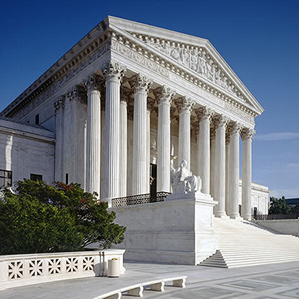U.S. Supreme Court Says “Natural” Human Genes May Not Be Patented
The U.S. Supreme Court gave a mixed ruling on the issue of human gene patents on Thursday, deciding that while DNA found naturally cannot be patented, synthetically produced DNA can.

The ruling means that companies will no longer be able to patent a sequence that exactly matches a sequence found in nature. Such sequences have been patented by companies that use them to determine someone’s risk of developing a certain disease. The patent holders have then been able to charge others to use that sequence as part of a medical test.
The court’s decision specifically relates to the question of whether one such company, Myriad Genetics, could patent the sequences of two genes, BRCA1 and BRCA2, that are related to the risk of breast and ovarian cancer. Recently, actress Angelina Jolie announced that she underwent a preventive double mastectomy after learning she carried risk mutations in BRCA1. Myriad had held exclusive rights to determine whether a woman carried certain genetic variants in these genes that would predispose her to those cancers. It charged some $3,000 for the test.
The court’s decision says that Myriad does not have an exclusive right to test for these variants because they are naturally occurring. However, it also says that if a researcher or lab technician isolates a non-natural version of the gene in question—something known as complementary DNA, or cDNA—that person or company does have the exclusive rights to that sequence.
“A naturally occurring DNA segment is a product of nature and not patent eligible merely because it has been isolated, but cDNA is patent eligible because it is not naturally occurring,” the court ruled. The decision could help clarify the best claim strategies for companies developing diagnostic tests (see “Questions over Gene Patents Shake Diagnostics Industry”).
In drawing this line between naturally occurring DNA and cDNA, the court was trying to encourage innovation within the industry, says Barbara Rudolph, an expert on biotechnology intellectual property, who is a partner with the law firm Finnegan. The court noted this balance in the patent system between creating incentives that lead to new invention and impeding access to information that would hamper invention, she says.
The distinction lies in the details of molecular biology and the way a gene is prepped to become the recipe for creating a protein. In genomic DNA, genes exist as a mixture of components called exons, which encode the information for making a protein, and noncoding sequences, known as introns. To make a protein, cellular machinery first transcribes a gene—exons, introns, and all—into an intermediary molecule. Cellular machinery then cuts out the introns from that intermediate, creating a mature messenger RNA or mRNA. In a cell, that mRNA would be used as a recipe for making a protein. Scientists can isolate that mRNA and use an enzyme to convert it into DNA, which is called complementary DNA or cDNA. That molecule and its nucleotide sequence, the court writes, does not exist in nature, so they are patentable.
In fact, cDNA does exist naturally. Retroviruses such as HIV convert their RNA-based genomes into cDNA before they integrate into a host genome. They do this using the same naturally occurring enzyme that scientists and technicians use to convert an mRNA template into a cDNA.
Although there are other ways of synthesizing DNA, the court’s decision emphases that patent eligibility lies in the sequence of that DNA and whether or not it matches a natural DNA sequence. However, “the extent of difference that you are going to need is not clear,” says Rudolph.
The impact of this decision on molecular diagnostics companies remains to be seen, but Hank Greely, director of the Center for Law and the Biosciences at the Stanford School of Medicine, says the decision won’t matter much to the genetics and biotech world. “There are thousands of patented genes used in genetic tests, but generally they are licensed on an open basis for a very low fee,” he says. “Myriad is the only company that has used strategies to get people upset.”
Even Myriad may not suffer too much from the decision. It will still have a competitive advantage because it has been building up its database of BRCA mutations for 15 years, Greely says: “Myriad is the best position to figure out what variants mean.”
Quest Diagnostics, the largest service testing lab, says that the court’s decision could create opportunities for the company to develop new testing services for diseases including hereditary breast cancer. “We now intend to validate and offer a BRCA1 and BRCA2 test service to physicians and patients later this year,” says a Quest spokeswoman, Wendy Bost.
The long-term impact of the decision will be hard to know because technologies continue to outgrow the details of the case. The decision also focused on DNA sequences, which is not going to be the focus of every diagnostic test claim. “Every patent claim is different,” Rudolph says.
Keep Reading
Most Popular
Large language models can do jaw-dropping things. But nobody knows exactly why.
And that's a problem. Figuring it out is one of the biggest scientific puzzles of our time and a crucial step towards controlling more powerful future models.
How scientists traced a mysterious covid case back to six toilets
When wastewater surveillance turns into a hunt for a single infected individual, the ethics get tricky.
The problem with plug-in hybrids? Their drivers.
Plug-in hybrids are often sold as a transition to EVs, but new data from Europe shows we’re still underestimating the emissions they produce.
Stay connected
Get the latest updates from
MIT Technology Review
Discover special offers, top stories, upcoming events, and more.